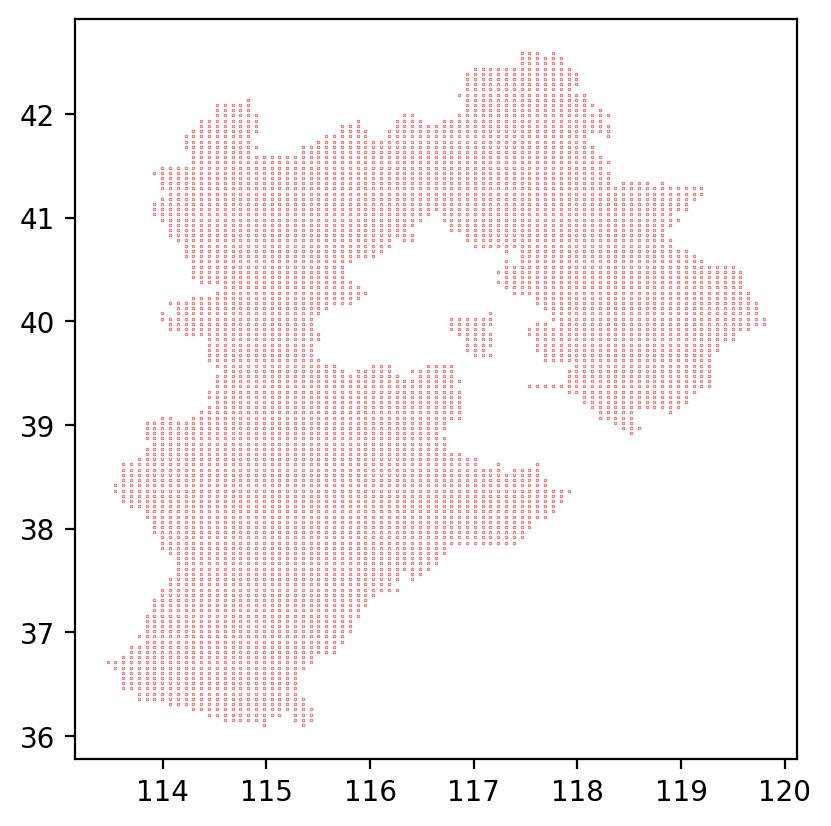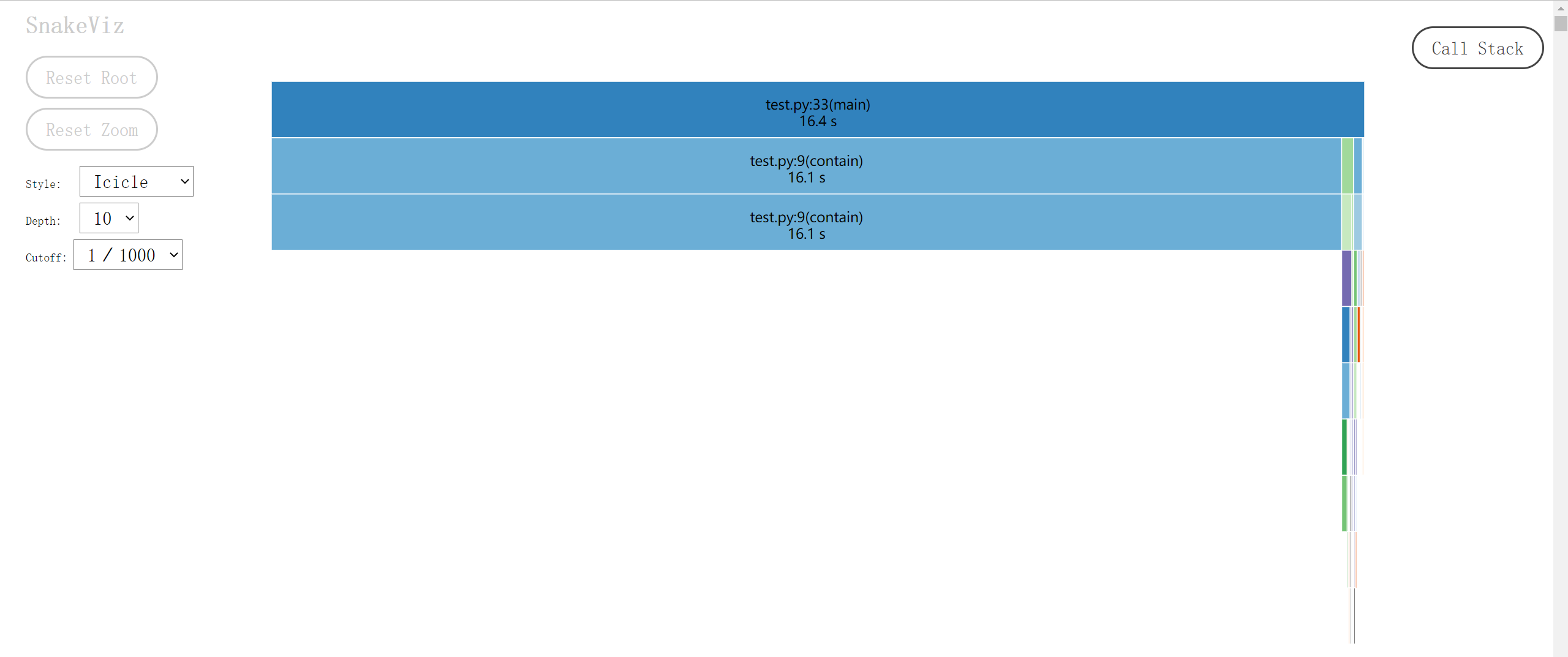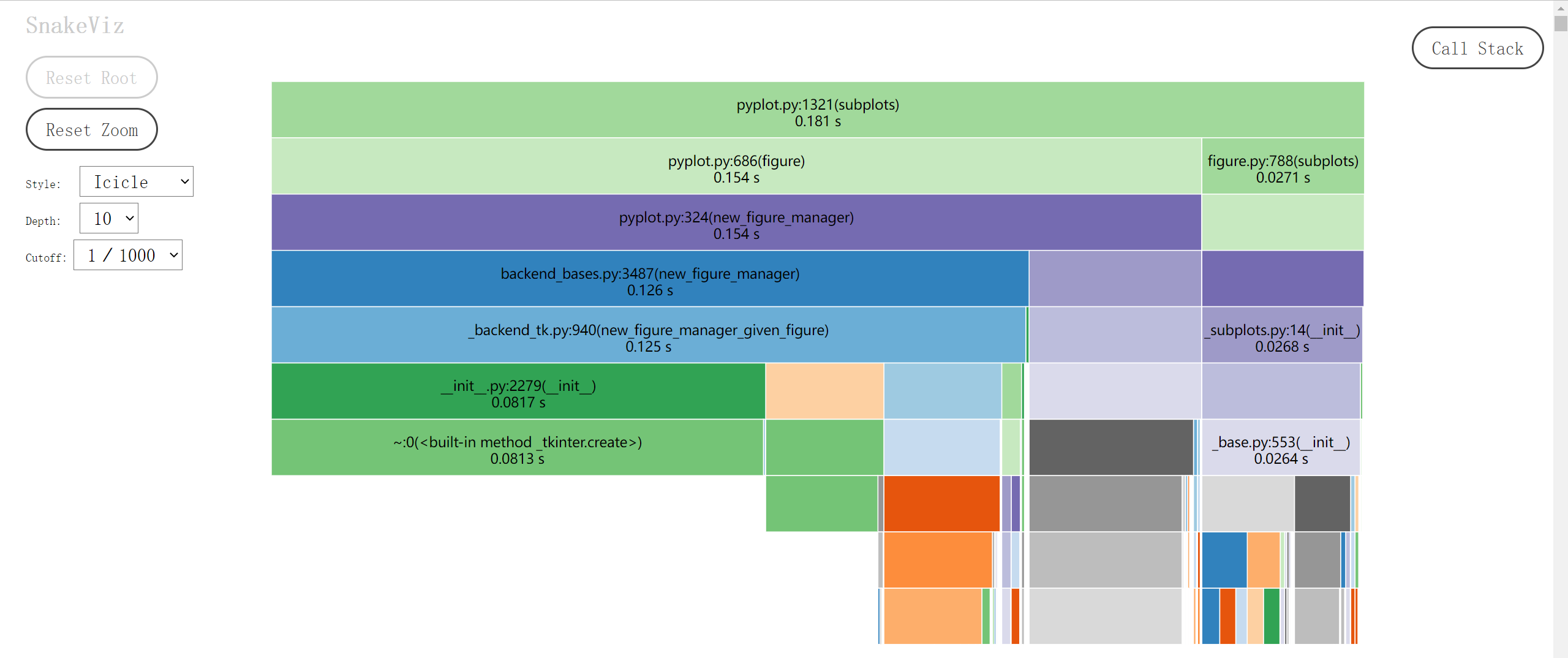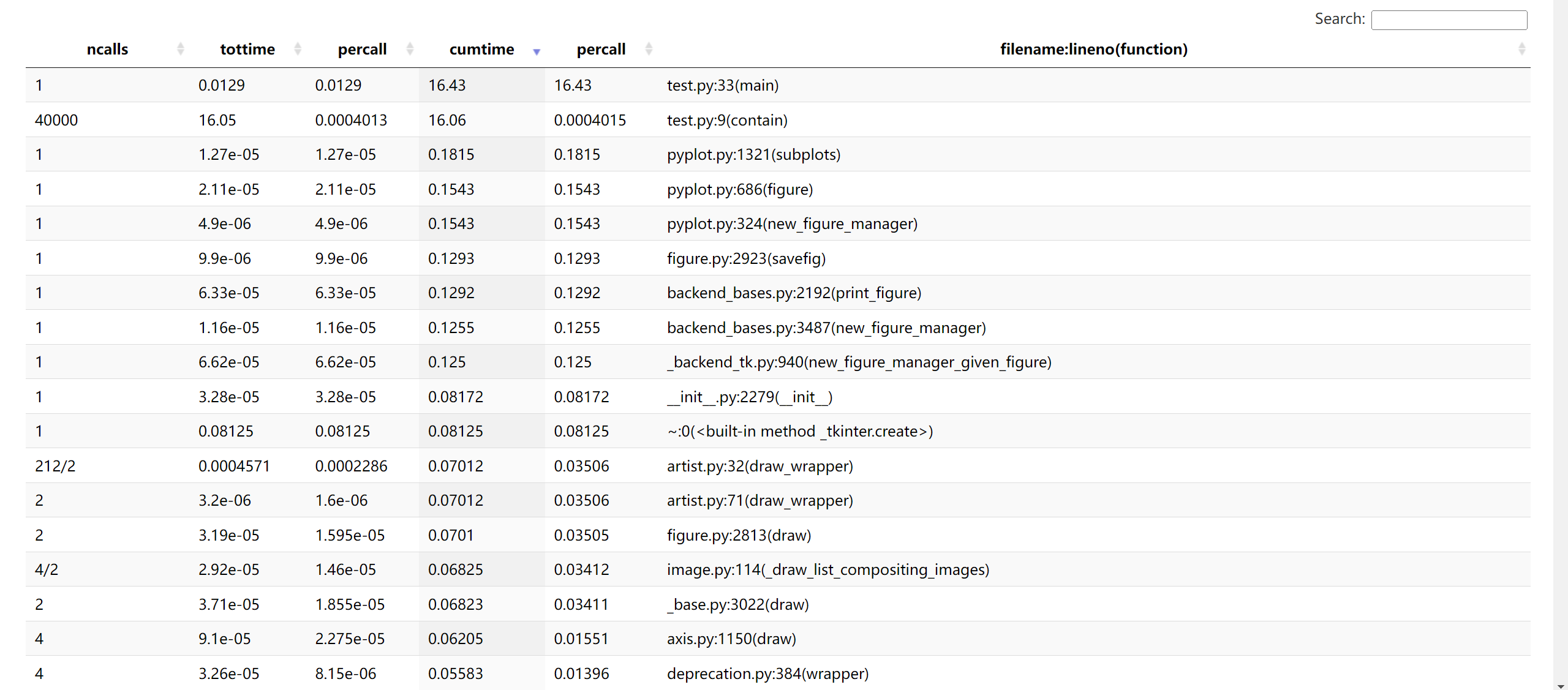

Python 系列:测量程序的运行时间
source link: https://zhajiman.github.io/post/python_measure_time/
Go to the source link to view the article. You can view the picture content, updated content and better typesetting reading experience. If the link is broken, please click the button below to view the snapshot at that time.

Python 系列:测量程序的运行时间
说到测量程序的运行时间这件事,我最早的做法是在桌上摆个手机,打开秒表应用,右手在命令行里敲回车的同时左手启动秒表,看屏幕上程序跑完后再马上按停秒表,最后在纸上记下时间。后来我在 Linux 上学会了在命令开头添加一个 time,终于摆脱了手动计时的原始操作。这次就想总结一下迄今为止我用过的那些测量时间的工具/代码。
测试代码是读取河北省省界的 GeoJSON 文件,利用射线法判断网格点有没有落入省界内部,最后通过 Matplotlib 画出示意图并保存。GeoJSON 数据来自阿里云的 DataV.GeoAtlas。代码 test.py 的内容如下
import json
import numpy as np
import matplotlib.pyplot as plt
def contain(polygon, x, y):
'''判断点是否落入多边形中.'''
if polygon['type'] == 'Polygon':
coords_polygons = [polygon['coordinates']]
elif polygon['type'] == 'MultiPolygon':
coords_polygons = polygon['coordinates']
else:
raise ValueError('输入不是多边形')
# 对每个多边形应用射线法.
for coords_polygon in coords_polygons:
flag = False
for coords_ring in coords_polygon:
for i in range(len(coords_ring) - 1):
x0, y0 = coords_ring[i]
x1, y1 = coords_ring[i + 1]
if y0 < y <= y1 or y1 < y <= y0:
if x < (x1 - x0) / (y1 - y0) * (y - y0) + x0:
flag = not flag
if flag:
return flag
return False
def main():
with open('河北省.json', encoding='utf-8') as f:
geoj = json.load(f)
hebei = geoj['features'][0]['geometry']
xs = []
ys = []
for x in np.linspace(110, 125, 200):
for y in np.linspace(35, 45, 200):
if contain(hebei, x, y):
xs.append(x)
ys.append(y)
fig, ax = plt.subplots()
ax.set_aspect('equal')
ax.plot(xs, ys, 'o', c='C3', ms=0.2)
fig.savefig('hebei.png', dpi=200, bbox_inches='tight')
plt.close(fig)
if __name__ == '__main__':
main()
输出图片为

Linux 的 time
在 Linux 的 Bash 中通过在命令前加上 time,即可在命令执行结束后打印出三种耗时
(base) laptop@zhajiman:/code$ time python test.py
real 0m22.993s
user 0m19.905s
sys 0m0.096s
其中 real 指总耗时(墙上时钟经过的时间,即 wall time),user 指用户态代码耗费的 CPU 时间,sys 指系统态代码耗费的 CPU 时间。一般看 real 的数值即可,关于三种时间的解释可见 linux time命令详解与坑。
Windows 的 Measure-Command
Windows 中类似的命令是 Powershell 的 Measure-Command 命令
(base) PS D:\code> Measure-Command {python test.py}
Days : 0
Hours : 0
Minutes : 0
Seconds : 16
Milliseconds : 442
Ticks : 164424518
TotalDays : 0.000190306155092593
TotalHours : 0.00456734772222222
TotalMinutes : 0.274040863333333
TotalSeconds : 16.4424518
TotalMilliseconds : 16442.4518
打印出了各种单位的耗时,一般看其中的 TotalSeconds 即可。不过该命令会吞掉 Python 程序本身的打印结果,这时可以通过管道在测量结束后把内容再打印出来
Measure-Command {python test.py | Out-Default}
显然 Linux 的 time 命令用起来要方便的多……
IPython 的魔法命令
IPython 中的 %run 命令可以直接执行脚本文件,加上 -t 参数时会输出耗时
In [1]: %run -t test.py
IPython CPU timings (estimated):
User : 16.17 s.
System : 0.00 s.
Wall time: 16.37 s.
输出结果跟 Linux 的 time 命令很像,不过文档说 Windows 下的 System 时间直接设成了 0。加上 -N <N> 参数可以重复执行 <N> 次,输出里会多出总时间和平均时间之分。
%time
%time 会打印出单条语句或表达式的耗时
In [2]: %time main()
CPU times: total: 16.6 s
Wall time: 16.8 s
结果由 CPU 时间和墙上时间组成。
%timeit
类似 %time,但为了得到精准的测量结果,会自动测量多次,以得到较为准确的平均耗时,还会为打印出来的结果挑选合适的单位(秒、毫秒、微秒等)。例如
In [3]: with open('河北省.json', encoding='utf-8') as f:
...: geoj = json.load(f)
...: hebei = geoj['features'][0]['geometry']
...:
In [4]: %timeit contain(hebei, 115, 40)
284 µs ± 4.63 µs per loop (mean ± std. dev. of 7 runs, 1,000 loops each)
%timeit 默认跑 7 组,每组自动设置成了 1000 次循环,最后计算平均耗时和标准差。加上 -n <N> 可以指定循环 <N> 次,-r <R> 可以指定跑 <R> 组。例如测一次 main 函数的耗时
In [5]: %timeit -n 1 -r 1 main()
15.4 s ± 0 ns per loop (mean ± std. dev. of 1 run, 1 loop each)
无论是 %time 还是 %timeit 都有一个缺陷:只能在 IPython 顶层的命名空间中使用。例如我想测试 contain(hebei, x, y) 对于单点的速度,因为变量 hebei 在函数 main 的命名空间里,而外部没有,所以我在使用 %timeit 前又在全局新建了 hebei 变量。我还试过设置断点通过 ipdb 跳到函数内,结果发现此时 %timeit 用不了,不知道读者有没有比较好的解决方法。
标准库的 time 模块
time 和 perf_counter 函数
time 模块的一个主要功能就是获取当前时间,所以只要在想计时的代码块开头获取一次时间,再在结尾获取一次,最后计算二者的差值就能得到代码块的耗时。例如
import time
if __name__ == '__main__':
t0 = time.time()
main()
t1 = time.time()
dt = t1 - t0
print(f'{dt:.1f}', 's')
打印结果为 15.4 s。其中 time.time 函数没有参数,在 Windows 和 Linux 平台上调用后返回 Unix 时间戳(自 1970-01-01 00:00:00 UTC 以来的秒数)。这个函数的问题是与系统时间相关联,如果两次调用之间系统时间发生了变动(例如在任务栏里手动修改、联网自动校正等),那么第二次调用的结果也会跟着变化,最后计算出错误的 dt。另外该函数在 Windows 平台的时间分辨率也比较低,会测不准耗时较短的语句。
time.perf_counter 是 Python 3.3 起引入的新函数,名字是 performance counter 之意,即专门用来测量性能(耗时)的计时器。调用后返回的浮点数本身没有明确的意义,只有两次调用时结果的差值有意义,表示过程中经过的秒数。相比 time,perf_counter 的时间分辨率更高,且不受系统时间变动的影响,结果始终保证单调递增。所以在测量程序耗时中更推荐使用 perf_counter。
if __name__ == '__main__':
t0 = time.perf_counter()
main()
t1 = time.perf_counter()
dt = t1 - t0
print(f'{dt:.1f}', 's')
另外 time 模块里还有一个 process_time 函数,说是能测量当前进程的用户态和系统态 CPU 时间之和,且不包含睡眠时间(例如调用 time.sleep 函数)。但我测试后发现测出来的时间经常比 perf_counter 的结果要大,实在让人摸不着头脑,所以这里就不多介绍了。
直接在程序中插入 perf_counter 的用法虽然很灵活,但改起来十分麻烦。如果只想测量函数的耗时,使用装饰器语法更方便:无需修改函数体或主程序,只需在定义函数的 def 语句前插入一行,就能为函数增加计时功能。下面编写一个带可选参数的计时装饰器
import time
import functools
def timer(func=None, *, prompt=True, fmt=None, prec=None, out=None):
'''
计时用的装饰器.
Parameters
----------
func : callable
需要被计时的函数或方法.
prompt : bool
是否打印计时结果.
fmt : str
打印格式. %n表示函数名, %t表示耗时.
prec : int
打印时的小数位数.
out : list
收集耗时的列表.
'''
if fmt is None:
fmt = '[%n] %t s'
if func is None:
return functools.partial(
timer, prompt=prompt, fmt=fmt, prec=prec, out=out
)
@functools.wraps(func)
def wrapper(*args, **kwargs):
t0 = time.perf_counter()
result = func(*args, **kwargs)
t1 = time.perf_counter()
dt = t1 - t0
# 是否打印结果.
if prompt:
st = str(dt) if prec is None else f'{dt:.{prec}f}'
info = fmt.replace('%n', func.__name__).replace('%t', st)
print(info)
# 是否输出到列表中.
if out is not None:
out.append(dt)
return result
return wrapper
装饰器相关的知识可见 入门Python装饰器。用法是在 main 函数前一行加上 @timer 即可,还可以通过参数控制装饰器的输出
results = []
@timer(fmt='Time spent by %n is %t s', prec=1, out=results)
def main():
<函数体省略>
Time spent by main is 16.9 s
同时耗时被保存到了全局的 results 列表中。如果想要测量的函数并非定义在当前文件里(例如第三方包里的函数),那么可以通过包装目标函数来实现。例如测量 figsave 方法的用时
timer(prec=1)(fig.savefig)('hebei.png', dpi=200, bbox_inches='tight')
[savefig] 0.148 s
标准库的 cProfile 模块
time 模块适合测量代码块或函数的总耗时,如果想深入了解组成代码的所有函数各占了多长时间,推荐使用标准库的 cProfile 模块。该模块能够对程序进行性能剖析(profile),详尽给出各种函数和方法被调用的次数和耗时。但也因为监控的层级过于深入,会在一定程度上拖慢原程序的运行速度。所以该模块适合分析程序内各部分的相对用时,而不适合做精确的性能比较(benchmark)。
命令行调用
直接在命令行调用会对整个脚本进行测量,无需对代码进行任何修改
python -m cProfile [-o output_file] [-s sort_order] myscript.py
-o 表示将剖析结果输出为二进制文件,如果不给出就将结果以表格的形式打印在屏幕上。-s 表示如果不输出文件,那么可以按 pstats 模块 Stats.sort_stats 方法的规则对打印的表格记录进行排序。由于表格一般巨长无比,所以打印到屏幕上意义不大,我会用管道输出到文本文件后再用编辑器来看。例如在 PowerShell 中可以
python -m cProfile -s cumtime test.py | Out-File -FilePath test.txt
表格前 20 行长这个样子
3372760 function calls (3338684 primitive calls) in 19.628 seconds
Ordered by: cumulative time
ncalls tottime percall cumtime percall filename:lineno(function)
782/1 0.003 0.000 19.629 19.629 {built-in method builtins.exec}
1 0.000 0.000 19.629 19.629 test.py:1(<module>)
1 0.028 0.028 17.907 17.907 test.py:33(main)
40000 17.519 0.000 17.532 0.000 test.py:9(contain)
96 0.003 0.000 3.383 0.035 __init__.py:1(<module>)
871/15 0.006 0.000 1.760 0.117 <frozen importlib._bootstrap>:1022(_find_and_load)
868/15 0.004 0.000 1.760 0.117 <frozen importlib._bootstrap>:987(_find_and_load_unlocked)
833/16 0.004 0.000 1.755 0.110 <frozen importlib._bootstrap>:664(_load_unlocked)
773/15 0.002 0.000 1.754 0.117 <frozen importlib._bootstrap_external>:877(exec_module)
1106/16 0.001 0.000 1.754 0.110 <frozen importlib._bootstrap>:233(_call_with_frames_removed)
535/25 0.001 0.000 1.659 0.066 {built-in method builtins.__import__}
1086/417 0.002 0.000 1.264 0.003 <frozen importlib._bootstrap>:1053(_handle_fromlist)
2652/2432 0.038 0.000 0.926 0.000 {built-in method builtins.__build_class__}
1 0.000 0.000 0.883 0.883 pyplot.py:1(<module>)
101 0.001 0.000 0.690 0.007 artist.py:128(_update_set_signature_and_docstring)
可以看到加了 cProfile 后程序耗时从 16 秒上升至 19 秒,期间共发生 3372760 次函数调用(不算递归的原始调用是 3338684 次)。表格各列的意义如下:
ncalls:函数调用的次数。正斜杠区分总次数和原始调用。tottime:每次调用的耗时之和,但如果函数内调用了其它函数,刨除掉在子函数中经过的时间。percall:tottime除以ncalls的值。cumtime:每次调用的耗时之和,包含花费在子函数上的时间。percall:cumtime除以原始调用次数的值。filename:lineno(function):函数所在的文件名、定义所在的行号,和函数名。
-s 选项可以按这些列名进行排序,文件名和行号的话用 filename 和 line。表格中总耗时排第一的是内置方法 exec,可能是 cProfile 需要用 exec 执行 test.py 中的语句;第二是作为整个模块的 test.py,再是 main 函数;第四的 contain 函数调用 200 * 200 = 40000 次,耗时 17 秒,说明整个程序中最耗时的操作就是判断点是否落入多边形。而画图相关的函数在表格中的排位并不算高。
程序内调用
如果想要指定测量范围,就需要在程序中显式调用 cProfile 模块。测量单条语句的耗时可以用:
cProfile.run(command, filename=None, sort=-1):command是用字符串表示的 Python 语句,该方法会用exec函数执行该语句并测量其耗时。filename参数用于将结果输出为文件,缺省时会打印出结果表格。sort参数类似上一节,对打印结果进行排序。cProfile.runctx(command, globals, locals, filename=None, sort=-1):传入run的语句仅能引用全局作用域中的对象,而runctx可以指定全局作用域和局部作用域的字典。
例如测量 main() 这一句的耗时,输出与上一节类似
import cProfile
if __name__ == '__main__':
cProfile.run('main()', sort='cumtime')
测量代码块的耗时需要构造 cProfile.Profile 对象,它相当于一个计时器,通过调用方法来开关,会把计时结果保存下来,之后可以选择打印或输出文件。具体方法为:
enable():开始测量。disable():结束测量。print_stats(sort=-1):在内部创建一个Stats对象并用它打印表格,用sort参数进行排序。dump_stats(filename):将测量结果输出到文件。run(cmd):类似cProfile.run,但没了打印和输出文件功能。runctx(cmd, globals, locals):类似cProfile.runctx。runcall(func, /, *args, **kwargs):相当于先enable(),再跑func(*args, **kwargs),然后disable()。
以画图部分的代码块为例,先在开头开启计时器,再在结尾停止计时
profile = cProfile.Profile()
profile.enable()
fig, ax = plt.subplots()
ax.set_aspect('equal')
ax.plot(xs, ys, 'o', c='C3', ms=0.2)
fig.savefig('hebei.png', dpi=200, bbox_inches='tight')
plt.close(fig)
profile.disable()
profile.print_stats('cumtime')
另外 Profile 类支持上下文管理器,允许用 with 语句控制计时器的开关。所以上例可以改写为
with cProfile.Profile() as profile:
fig, ax = plt.subplots()
ax.set_aspect('equal')
ax.plot(xs, ys, 'o', c='C3', ms=0.2)
fig.savefig('hebei.png', dpi=200, bbox_inches='tight')
plt.close(fig)
profile.print_stats('cumtime')
前 20 行结果为,可以看到保存图片的语句耗时最长
199075 function calls (195323 primitive calls) in 0.454 seconds
Ordered by: cumulative time
ncalls tottime percall cumtime percall filename:lineno(function)
1 0.000 0.000 0.251 0.251 figure.py:2923(savefig)
1 0.000 0.000 0.251 0.251 backend_bases.py:2192(print_figure)
1 0.000 0.000 0.192 0.192 pyplot.py:1321(subplots)
1 0.000 0.000 0.165 0.165 pyplot.py:686(figure)
1 0.000 0.000 0.165 0.165 pyplot.py:324(new_figure_manager)
1 0.000 0.000 0.130 0.130 backend_bases.py:3487(new_figure_manager)
1 0.000 0.000 0.129 0.129 _backend_tk.py:940(new_figure_manager_given_figure)
2 0.000 0.000 0.125 0.063 artist.py:71(draw_wrapper)
212/2 0.001 0.000 0.125 0.063 artist.py:32(draw_wrapper)
2 0.000 0.000 0.125 0.063 figure.py:2813(draw)
4/2 0.000 0.000 0.122 0.061 image.py:114(_draw_list_compositing_images)
2 0.000 0.000 0.122 0.061 _base.py:3022(draw)
4 0.000 0.000 0.113 0.028 axis.py:1150(draw)
4 0.000 0.000 0.111 0.028 deprecation.py:384(wrapper)
2 0.000 0.000 0.109 0.054 backend_bases.py:1595(wrapper)
编写一个测量函数用时并保存结果的装饰器
import cProfile
import functools
def cprofiler(filename):
'''cProfile的装饰器. 保存结果到指定路径.'''
def decorator(func):
@functools.wraps(func)
def wrapper(*args, **kwargs):
with cProfile.Profile() as profile:
result = func(*args, **kwargs)
profile.dump_stats(filename)
return result
return wrapper
return decorator
使用方法为
@cprofiler('main.prof')
def main():
<函数体省略>
可视化结果
cProfile 模块输出的二进制文件可以用 pstats 模块的 Stats 类进行读取,它相当于一个表格对象,能对记录进行复杂的排序、只打印前 n 条记录等。还可以直接用记录了测量结果的 Profile 对象构造 Stats 对象。Profile.print_stats 方法其实就是借助 Stats.print_stats 实现的。不过个人觉得这个模块挺鸡肋,不如直接 Profile.print_stats('cumtime') 结合管道导出文本文件,然后再在文本编辑器中查看。
除此之外,另一个直观查看结果的方式就是用第三方包做可视化。这里介绍 snakeviz 包,通过 pip 或 conda 即可安装,使用方法非常简单,在命令行执行
snakeviz main.prof
就能解析 main.prof 文件,在弹出的网页里展示可视化结果。下图是各函数耗时的冰柱图(icicle):最顶层的长条矩形是被 cProfile.Profile 包裹的 main 函数,下一层则将上一层的矩形细分为不同颜色的子矩形,对应于 main 的函数体中被调用的各种函数,矩形长度正比于耗时。再下一层又会细分上一层的函数调用,如此不断深入,直至某个函数仅由内置语句和函数组成,或调用了其它语言的库文件。最后图片会自上而下形成一个个小山丘,又似冬天屋檐上结成的冰柱,各函数的耗时情况一目了然。Snakeviz 的网页里可以用鼠标点击感兴趣的矩形,会以这个函数为顶层放大冰柱图的细节,之后可以点击左边的 Reset Zoom 按钮返回初始状态。


网页下半部分还有表格结果,点击列名以排序,点击行以做出该函数为顶层的冰柱图。这样一来连打印表格的 Profile.print_stats 都可以省去了。

除 snakeviz 外,还有 gprof2dot、flameprof 等工具可选。
line_profiler 模块
cProfile 只能监测函数和方法的耗时,并且会深入到最底层的调用,有时我们并不需要如此详细的信息,只是想了解每一行的耗时。这种情况下第三方模块 line_profiler 可能会更合适,正如它的名字所示,测量的是函数体每一行语句的耗时。同样是 pip 或 conda 安装。
程序内调用
line_profiler.LineProfiler 只提供对函数的测量功能,在构造时需要传入目标函数,也可以后面再添加
from line_profiler import LineProfiler
profile = LineProfiler(f, g)
profile.add_function(h)
常用的方法有:
run(cmd):测量一条语句的耗时。但如果语句中不含对目标函数的调用,那就啥也测不到。runctx(cmd, globals, locals):可以传入环境的run。runcall(func, *args, **kw): 测量func(*args, **kw)耗时。当然前提是之前添加过func函数。enable_by_count():据文档说是解决了嵌套安全性的enable。disable_by_count():同上。print_stats(self, stream=None, output_unit=None, stripzeros=False):打印结果,stream指定输出流(默认屏幕),output_unit指定结果中的时间单位(后面再解释),stripzeros指定是否隐藏未被调用的函数。dump_stats(self, filename):以二进制格式导出文件。
以 main 函数为例
if __name__ == '__main__':
profile = LineProfiler(main)
profile.enable_by_count()
main()
profile.disable_by_count()
profile.dump_stats('main.lprof')
生成的二进制文件通过下面的命令打印
python -m line_profiler main.lprof
Timer unit: 1e-06 s
Total time: 60.5731 s
File: D:\code\python\profiler\test.py
Function: main at line 34
Line # Hits Time Per Hit % Time Line Contents
==============================================================
34 def main():
35 2 87.8 43.9 0.0 with open('河北省.json', encoding='utf-8') as f:
36 1 895.7 895.7 0.0 geoj = json.load(f)
37 1 1.4 1.4 0.0 hebei = geoj['features'][0]['geometry']
38
39 1 0.7 0.7 0.0 xs = []
40 1 0.5 0.5 0.0 ys = []
41 201 295.5 1.5 0.0 for x in np.linspace(110, 125, 200):
42 40200 59299.5 1.5 0.1 for y in np.linspace(35, 45, 200):
43 40000 60157225.0 1503.9 99.3 if contain(hebei, x, y):
44 5226 9045.1 1.7 0.0 xs.append(x)
45 5226 3818.1 0.7 0.0 ys.append(y)
46
47 1 188088.4 188088.4 0.3 fig, ax = plt.subplots()
48 1 34.6 34.6 0.0 ax.set_aspect('equal')
49 1 1567.8 1567.8 0.0 ax.plot(xs, ys, 'o', c='C3', ms=0.2)
50 1 145367.5 145367.5 0.2 fig.savefig('hebei.png', dpi=200, bbox_inches='tight')
51 1 7339.0 7339.0 0.0 plt.close(fig)
Line:行号。Hits:这一行被“命中”(执行)了几次。Time:这一行的总耗时。乘上开头的时间单位Timer unit后才是真实数值。Per Hit:Time/Hits的值,表示每次执行的平均耗时。% Time:百分数形式的Time。Line Contents:这一行语句的内容。
因为表格内容非常清晰易懂,所以不需要做什么可视化,并且也不会像 cProfile 那样出现一堆见都没见过的函数。令人大跌眼镜的是,被测量的 main 函数耗时从 16 秒暴增至 60 秒。暗示循环语句太多时测量会严重拖慢程序,幸好我们更关心的是 % Time 列的内容,即哪一行占的时间最多。显然 contain 占据了 99.3 %,这提示我们 contain 函数应该是优化的首要对象。
上面的用法还可以改写为
if __name__ == '__main__':
profile = LineProfiler(main)
profile.runcall(main)
profile.print_stats()
然后用管道输出文本结果,这样就可以省去中间的 test.lprof 文件和 python -m 命令。
LineProfiler 类的实例可以直接用作装饰器,会自动通过 add_function 方法添加目标函数。例如
profile = LineProfiler()
@profile
def contain(polygon, x, y):
<函数体省略>
if __name__ == '__main__':
main()
profile.print_stats()
另外也可以自己实现一个保存结果的装饰器
def lprofiler(filename):
'''line_profiler的装饰器. 保存结果到指定路径.'''
def decorator(func):
@functools.wraps(func)
def wrapper(*args, **kwargs):
profile = LineProfiler(func)
result = profile.runcall(func, *args, **kwargs)
profile.dump_stats(filename)
return result
return wrapper
return decorator
不过自己写的版本有个毛病,反复调用被装饰的函数会重写结果文件,导致无法测量累积用时。
kernprof
kernprof 是 line_profiler 附带的一个脚本,作用是简化调用 LineProfiler 的流程,自动输出结果文件。在命令行里用它代替 Python 命令执行脚本时,会先构造一个名为 profile 的 LineProfiler 对象,并将其注入脚本的命名空间。这样一来脚本开头无需添加 import 语句就能直接引用 profile 变量,接着用它装饰目标函数即可。这也是 line_profiler 文档的推荐用法。例如在脚本中加上一行
@profile
def main():
<函数体省略>
也不需要写什么 profile.dump_stats(filename),直接在命令行执行
kernprof -l test.py
就会在当前目录自动生成 test.py.lprof 文件。kernprof 的详细用法可以用 -h 选项查看,下面列举几条常用的:
-l, --line-by-line:给出时使用 line_profiler,否则使用 cProfile。-b, --builtin:是否把profile注入脚本。-l时默认开启。-o OUTFILE, --outfile OUTFILE:将结果输出至OUTFILE文件。不给出时默认以脚本名.prof或脚本名.lprof为名保存到当前目录。-v, --view:是否顺便打印出结果。
其中 -l 选项提到了可以使用 cProfile,kernprof 对 cProfile.Profile 进行了包装,为其增加了装饰器功能,用法跟前面一样。以测量代码块为例
with profile:
<代码块省略>
不加 -l,记得加 -b
kernprof -b test.py
会在当前目录自动生成 test.py.prof 文件,接着可以交给 snakeviz 去可视化。
由简到繁总结一下上述工具的使用场景:
- 测量脚本用时:系统命令或 IPython 的
%run。 - 测量函数用时:IPython 的
%time、%timeit。 - 测量代码块用时:time 模块。
- 测量函数每一行的用时:line_profiler 模块。
- 测量函数或代码块所有调用的用时:cProfile 模块。
因笔者对 Jupyter Notebook 不熟,所以没能介绍 %time 和 %timeit 的 cell 版本。另外也没能测试多进程下各工具的表现,专门提到这个是因为笔者在实际操作中经历过 line_profiler 和 kernprof 在多进程脚本中失效的现象。以后有机会再总结一下这些内容。
Point-In-Polygon Algorithm — Determining Whether A Point Is Inside A Complex Polygon
Windows equivalent to UNIX “time” command
IPython: Built-in magic commands
Understanding time.perf_counter() and time.process_time()
关于python中time.perf_counter() 与 time.process_time()分析与疑问
Python Cookbook: 9.6 带可选参数的装饰器
Recommend
About Joyk
Aggregate valuable and interesting links.
Joyk means Joy of geeK